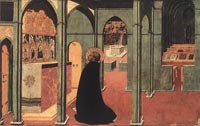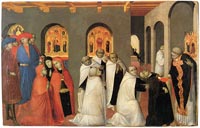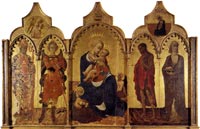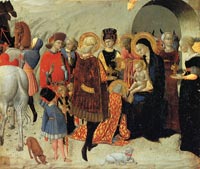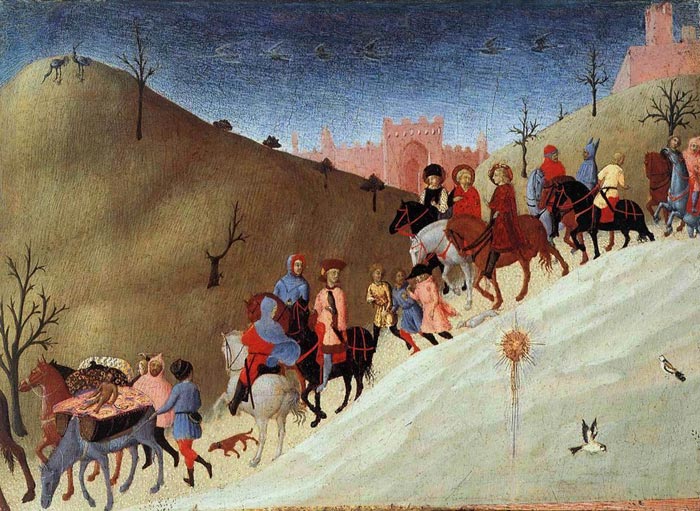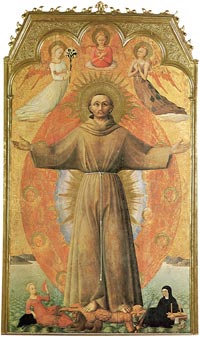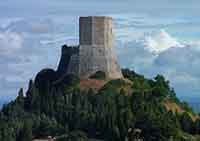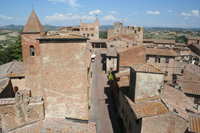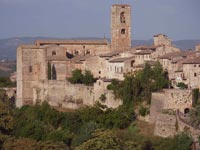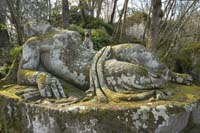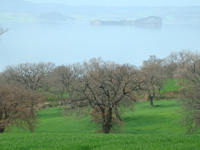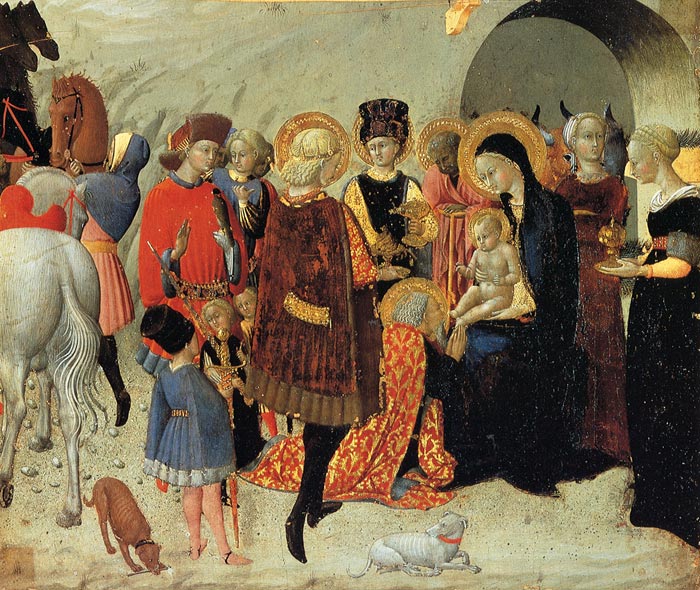 |
|
Sassetta, Adorazione dei Magi, tavola divisa in due parti (1435 circa): la parte inferiore a Siena, Collezione Chigi-Saracini (proprietà del Monte dei Paschi di Siena); la parte superiore (Corteo dei Magi) a New York, Metropolitan Museum of art |
|
Sassetta (Stefano di Giovanni) |
Il Sassetta, pseudonimo di Stefano di Giovanni di Consolo (Cortona?, 1400 circa – Siena, 1450), è stato un pittore italiano. |
||
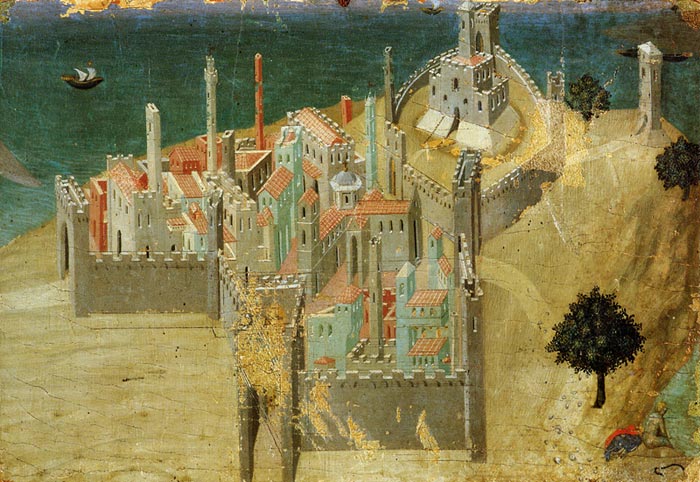 |
||
Sassetta, City by the Sea (view of Talamone), (c.1340), Siena, Pinacoteca, formerly attributed to Ambrogio Lorenzetti |
||
|
||
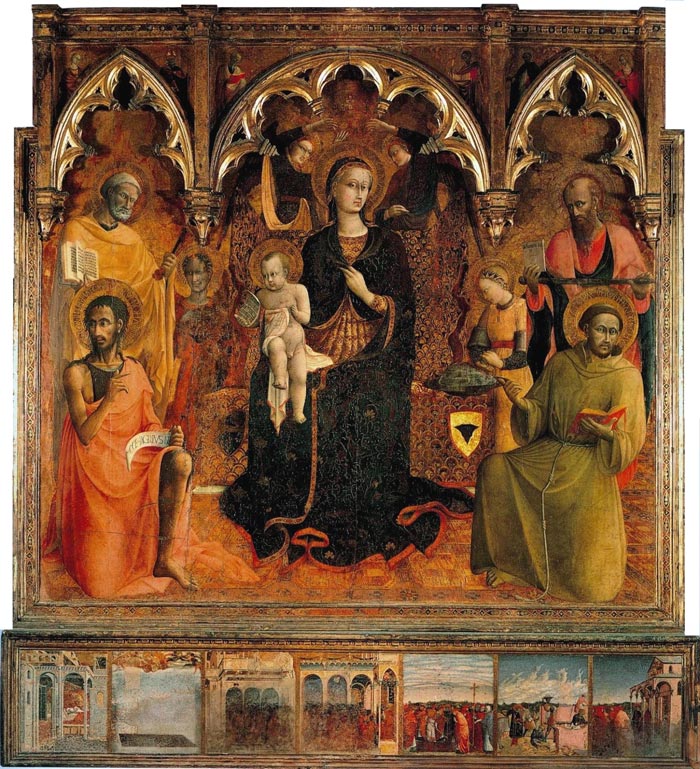 |
||
Sassetta, The Virgin and Child with Saints, 1430-32, Galleria degli Uffizi, Florence |
||
Intorno al 1430 una gentildonna senese, Ludovica Bertini, vedova di Turino di Matteo, Operaio della Cattedrale, commissionò al più rinomato ed apprezzato pittore dell’epoca, Stefano di Giovanni di Consolo, forse da Cortona o forse da Siena, detto Il Sassetta una pala d’altare raffigurante la Madonna della Neve. Nel 1591 la pala fu rimossa e collocata nei magazzini dell’opera. |
||
| The imagery of the altarpiece was elaborated in order to honour two of the Virgin's titles - 'Queen of Heaven' and 'Our Lady of the Snows'. Two angels behind the throne hold a crown over the Virgin's head. The angel on the left of the throne, meanwhile, carries a dish filled with snow and the angel on the right makes a snowball. The seven narrative scenes of the predella describe in detail the legend of Our Lady of the Snows. They show how, in the reign of Pope Liberius (352-66), the Virgin caused snow to fall miraculously in the heat of August on the Esquiline Hill in Rome. Furthermore, the snow fell precisely in the pattern of the ground plan of a church. The Virgin then instructed a wealthy layman and his wife, and Pope Liberius, to build a church in her honour on this site - a church that became Santa Maria Maggiore, one of Rome's major basilicas. Quite unlike the hieratic aura of the main scene, the predella panel recording the miracle of the snow in founding of Santa Maria Maggiore in Rome, is full of naturalistic elements, and even the arrangement and presentation of the figures is casual and almost journalistic. Although the condition of the predella is not as good as that of the main panel, the atmospheric environment created for the outdoor scene is still legible. |
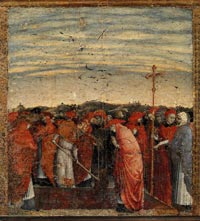 Sassetta, Founding of Santa Maria Maggiore, 1430-32, Galleria Palatina (Palazzo Pitti), Florence Sassetta, Founding of Santa Maria Maggiore, 1430-32, Galleria Palatina (Palazzo Pitti), Florence |
|
Arte della Lana Altarpiece (Altar of the Eucharist)
|
||
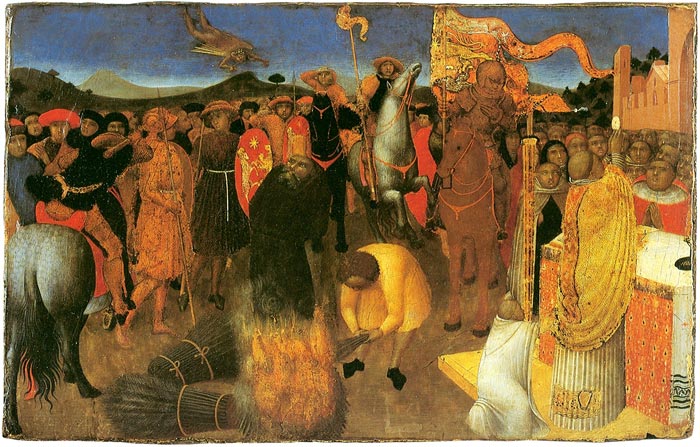 |
||
Sassetta, Death of the Heretic on the Bonfire, 1423, National Gallery of Victoria, Melbourne. The picture shows one of the predella paintings of the Altar of the Eucharist. |
||
| The Arte della Lana Altarpiece, the first known work by Sassetta, was commissioned by the "Arte della Lana", i.e. the woolmerchants' guild for the church of the Carmelite Order in Siena in 1423. Sassetta's Wool Guild altarpiece was an ingeniously movable yet highly elaborate gothic triptych that the guild used for its outdoor celebration of the Feast of Corpus Domini and otherwise stored in its palace. The triptych was dissembled in 1777, and the central panel is lost, but it is possible to reconstruct its original arrangement from earlier descriptions. According to these, the central panel represented the Holy Sacrament in an ostensory adored by a number of angels around it. Above this there was the scene of the Coronation of the Virgin, and on the sides Abbot S. Anthony and S. Thomas Aquinas were depicted. Above these the scene of the Annunciation was represented in two separate pictures. On the predella underneath the main panel, seven small panels showed the following scenes: 1-2. Two scenes from the life of S. Anthony, one of them is about his temptation (Siena, Pinacoteca); 3. Execution of an Heretic on the Bonfire (Melbourne Museum); 4. The Last Supper (Siena, Pinacoteca); 5. The Miracle of the Holy Sacrament (Barnard Castle, Bowes Museum); 6. S. Thomas Aquinas in Prayer in front of the Altar of the Virgin (Budapest, Museum of Fine Arts); 7. S. Thomas Aquinas in Prayer in front of the Crucifix (Vatican, Pinacoteca). Further to the above mentioned ones we know eight panels from the external pillars that represented the Four Doctors of the Church: S. Jerome, Gregory, Ambrose, Augustine as well as the four patron saints of Siena: S. Ansanus, Victor, Savinus and Crescentius. Two small panels from the pinnacles with the figures of the Prophets Elias and Eliseus still exist in the Sienese Picture Gallery. Under the central panel the following inscription was visible: "Hinc opus omne Patres Stefanus construxit ad aras Senensis Johannis agens citra lapsus adultos". The interpretation of this distych is much debated. The iconographic programme of the altar was probably composed by the Carmelite monks. That is why the two prophets, Elias and Eliseus, the "Dux et Pater" and the Pater of the Carmelites were represented on the altar, and in Carmelite habit. We can also see a few Carmelite monks in the pictures of the predella. Sassetta, here shows that he was in touch with all the most recent tendencies of European late-Gothic (which probably came to him by way of the exquisite painting of Masolino da Panicale), while at the same time he went further with the Lorenzetti's intuitions of space, adding realistic features unknown to the previous tradition. Thus, for example, in the St. Antony Beaten by Devils (one of the panels of the above-mentioned predella), the depth and articulation of the landscape is for the first time seen against a blue sky streaked with white clouds, instead of the customary gold background In the Adoration of the Magi in the Chigi Saracini Collection in Siena, a fragment of a larger composition which included the Journey of the Magi in the Griggs Collection in New York, we clearly see that Sassetta was greatly attracted by the art of Gentile da Fabriano, who spent some time in Siena in 1425 and 1426. But it is with the great altar-frontal of the Madonna della Neve, painted in 1430-32 for the Cathedral of Siena and now in the Contini Bonacossi Foundation (Uffizi), that he clearly shows how far he adhered to the "great Florentine concepts of form in perspective" (Graziani), even if these do not have much effect on the composition, but rather tend to stimulate occasional brilliant innovations. Art in Tuscany | Sassetta | Arte della Lana Altarpiece |
||
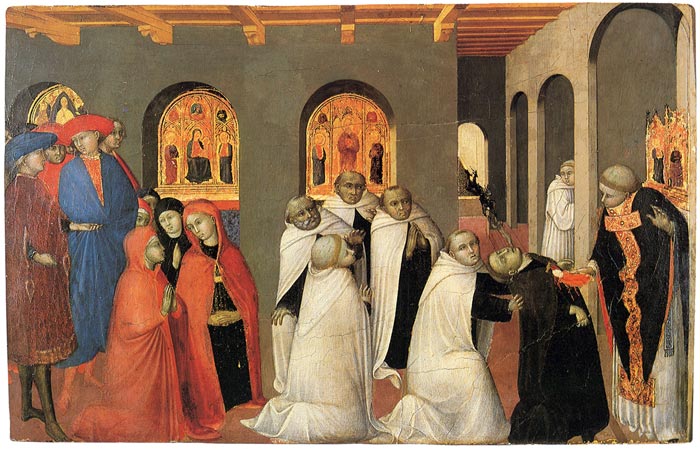 |
||
The small panel, A Miracle of the Sacrament or A Miracle of the Eucharist by Sassetta, painted in Siena c1423-25, has a dramatic tale to tell. It shows a cleric, struck dead as he is offered the Host during Mass. Even more dramatically, a devil swoops down to snatch his soul as it leaves his body. |
||
Virgin with Child and Four Saints |
||
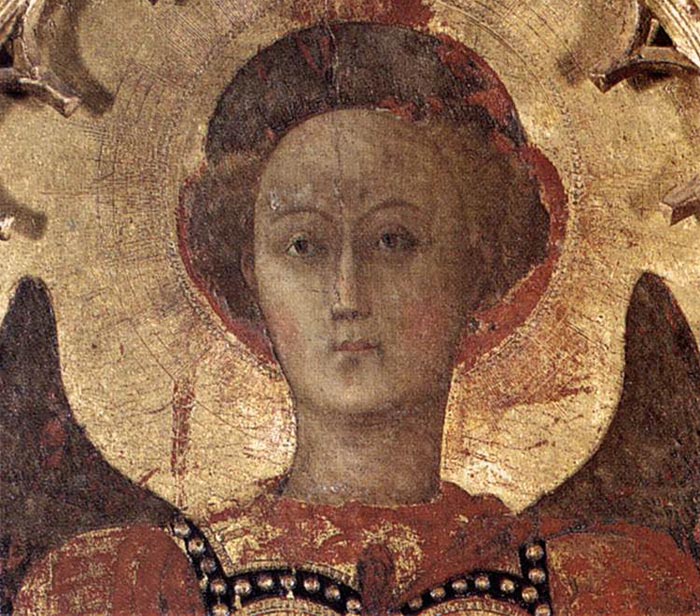 |
||
Sassetta, Madonna col Bambino e quattro santi, (dettaglio), Museo Diocesano, Cortona |
||
| In the centre of the polyptych there is an exquisite Virgin with Child. On the left side there are Sts Nicholas and Michael, wearing rare, refined, and precious garments. St Nicholas has a chasuble bearing a Pietà. The two saints on the right side are St John the Baptist and St Margaret of Hungary. Above the side panels are two tondi representing the Annunciation. The triptych was placed on a lateral altar in the church of St Dominic in Cortona. At the beginning of the Second World War it was immured in the belfry where the wood suffered much damage due to humidity and temperatures. It was necessary to detach the painted surface and transfer it to a new base. It has been restored after many succeeding interventions. Unfortunately, it has lost its original solidity and need continuous reexamination. |
||
|
||
| Adoration of the Magi, about 1435 |
||
| L’Adorazione dei Magi del Sassetta, vero e proprio capolavoro dell’arte senese del Quattrocento e proveniente dalla vasta ed importante collezione Chigi Saracini (costituita fra Settecento e Ottocento da Galgano Saracini, membro della nobile famiglia senese da cui i Chigi ereditarono i beni al termine del XIX secolo), è oggi di proprietà di Banca Monte dei Paschi di Siena. Questa tavola dipinta costituisce la parte più consistente di una pala che, visto il formato più ridotto del consueto, doveva essere destinata ad un altare domestico o ad una cappella privata e che ha subito in un lontano passato una brutale decurtazione, dovuta con ogni probabilità a motivi di commercio. In effetti, faceva parte originariamente dello stesso dipinto, raffigurante l’Adorazione dei magi, anche il pannello con il viaggio dei magi di misure ben più ridotte conservato oggi nel Metropolitan Museum of Art di New York e si deve a John Pope Hennessy (Sassetta, London 1939, pp. 80-85) il riconoscimento che le due tavole, unite assieme, formavano in origine una medesima composizione. Purtroppo la perdita di ampie zone della tavola dipinta ci impedisce oggi di ricostruire, sia pur idealmente, la composizione nella sue interezza, dato che importanti elementi di raccordo, come le parti relative al tetto della capanna e ad alcune zone del paesaggio collinare, andarono barbaramente segate e disperse. Possiamo esser certi però che la stella cometa, presente nel pannello di New York, era posta in corrispondenza della sottostante testa di Gesù Bambino, che compare invece nella tavola Chigi-Saracini. Questo significa che la porzione più piccola della pala, quella oggi negli Stati Uniti, era collocata in alto al centro della figurazione, mentre ampie zone del cielo e del paesaggio circostante andarono perdute al momento della decurtazione [1] |
||
|
||
Sassetta, Viaggio dei Re Magii (dettaglio), ca. 1435, Collezione M.F. Griggs
|
||
| San Sepolcro Altarpiece |
||
 |
||
Sassetta, Madonna col Bambino e angeli, San Sepolcro Altarpiece, 1437-44, Musée du Louvre, Parigi
|
||
Echoes of Masaccio and Paolo Uccello can be seen in the great Crucifix painted (probably in 1433) for the church of San Martino in Siena, some fragments of which are in the Chigi Saracini Collection, and in the polyptych of the church of San Domenico at Cortona. These are works that herald the condensed and yet vibrant sculptural precision of this painter's later style. This precision is represented by the great polyptych painted on both sides on which the artist worked from 1437 to 1444 for the Franciscan church of Borgo San Sepolcro, and which was dismembered at the beginning of the last century.
|
||
In 1940 the critic Roberto Longhi realized that it was difficult to find a place in the development of Sassetta's style for the triptych showing the Madonna and Child between St. Jerome and St. Ambrose in the Basilica dell'Osservanza in Siena.
|
||
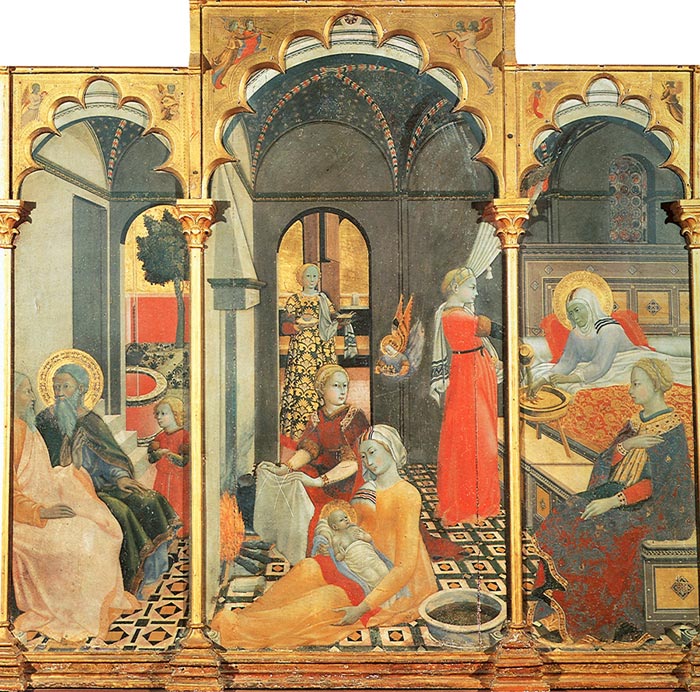 |
||
Master of the Osservanza, Birth of the Virgin with other Scenes from her Life, ca. 1428-39, Museo d'Arte Sacra, Asciano |
||
| Sassetta: The Borgo San Sepolcro Altarpiece, by Machtelt Israels (Editor), James R. Banker (Contributions by), Rachel Billinge (Contributions by), Roberto Bellucci (Contributions by), 2009, Florence & Leiden, Villa I Tatti/ The Harvard University Center for Italian Renaissance Studies/ Primavera Press. Borgo San Sepolcro, strategico tra Toscana, Umbria e Marche, da sempre il più popoloso centro dell'Alta Val di Tevere, è stato snodo fondamentale per la circolazione di uomini, merci e idee nell'Italia centrale. Inoltre, durante il '400 è tra i punti nevralgici in cui si gioca il processo di espansione territoriale di Firenze, che dopo la battaglia di Anghiari riesce a entrare in possesso di questa antica e illustre comunità. Nel 1441, infatti, papa Eugenio IV per la bella somma di 25.000 ducati cede San Sepolcro a Firenze. L'evento, visto dall'ottica senese, è un disastro, poiché i senesi avevano sperato di contrastare il primato fiorentino, tra l'altro inviando a lavorare nella città tiberina maestri di raffinatissimo mestiere, Giovanni di Stefano detto il Sassetta e il meno noto, ma altrettanto sofisticato e aggiornato Pietro di Giovanni Ambrosi. In pratica i due artisti propagandavano Siena come riferimento alternativo a Firenze. Non a caso nel volume che qui si presenta si segnalano nella stessa zona traffici finanziari che impegnano una facoltosa famiglia di banchieri senesi, quella di Ugo di Francio Berti, imparentata alla consorteria cittadina più esposta nella lotta contro Firenze, i Petrucci. Non si tratta di semplice trouvaille erudita, bensì informazione che meriterebbe trattazione a sé. Tutti i fatti decisivi della storia italiana del Rinascimento si accompagnano a capolavori e alla battaglia di Anghiari è associato il nome di Leonardo e i disegni che immortalano la vittoria fiorentina. La pala del Sassetta, realizzata fra 1437 e 1444, un vertice della grande scuola pittorica senese, rappresenta la parte che ad Anghiari è stata sconfitta. L'opera merita la massima attenzione sia per il valore intrinseco, sia per il significato storico, da leggersi in parallelo all'azione dell'Osservanza francescana e soprattutto di san Bernardino da Siena, la massima autorità morale del tempo, che ha esercitato influenza non solo in campo religioso, ma anche politico ed economico. Tra i motivi d'interesse del bel libro riccamente illustrato, edito a cura di Machelt Israels, si segnala appunto l'indagine intorno alla presenza francescana a Borgo San Sepolcro. La grande pala, infatti, è stata concepita per il convento di San Francesco in concomitanza con la predicazione bernardiniana, che durante la quarantennale attività del grande predicatore non è mai stata estranea ai progetti politici di marchio visconteo. Il duca di Milano, Filippo Maria Visconti, il grande sconfitto di Anghiari, è stato tra i principali patrocinatori di san Bernardino e questi, capace di presentarsi super partes e oggetto di somma stima anche presso Eugenio IV, era considerato mediatore indispensabile nelle aree ad alta tensione politica. Ma il libro, cui hanno collaborato studiosi di chiara fama, analizza molto altro: la storia critica dell'opera, la vicenda dello smembramento fra ben dodici musei, che fa della pala un caso esemplare per la storia del collezionismo, la ricezione del linguaggio sassettesco, che rende inevitabile il confronto con un genio, Piero della Francesca, senza trascurare la componente liturgica, il restauro e l'aspetto più concreto dell'opera, vale a dire l'ammirevole carpenteria. In sintesi, si tratta di un libro ponderoso, nonché contributo significativo agli studi senesi e non solo. [Petra Pertici, Bullettino Senese di Storia Patria, 117, 2010] |
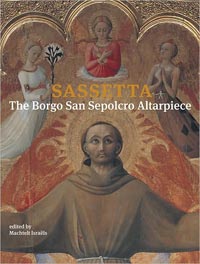 Machtelt Israels, Sassetta: The Borgo San Sepolcro Altarpiece Machtelt Israels, Sassetta: The Borgo San Sepolcro Altarpiece |
|||
E. Carli, Sassetta e il Maestro dell'Osservanza, Milan, 1958.
|
||||
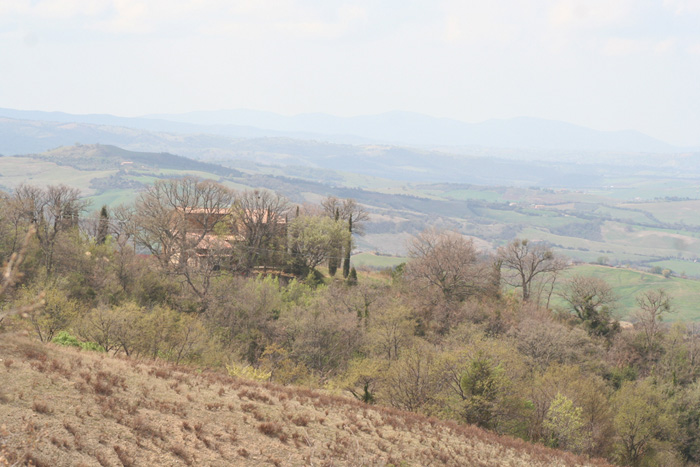 |
||||
Podere Santa Pia è situata sulla sommità di una collina all’interno della Maremma da cui si gode una splendida vista sull’intera vallata, dai Monti dell’Uccellina fino al mare e Monte Christo . |
||||
|
||||
 |
||||
Podere Santa Pia |
Castiglioncello Bandini |
Sant'Antimo |
||
Sovicille |
Certaldo |
Colle Val d'Elsa |
||
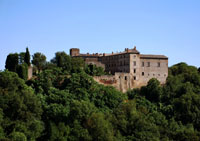 |
||||
Il parco dei Mostri in Bomarzo |
Lago Bolsena
|
Montecalvello |
||
 |
||||
Podere Santa Pia, immersa nella splendida campagna della Maremma, è situato in una splendida posizione panoramica, a pochi chilometri da Montalcino e Abbazzia Sant' Antimo. |
||||
Questo articolo è basato sugli articoli Sassetta, Pietro Perugino e Villa I Tatti dell' enciclopedia Wikipedia ed è rilasciato sotto i termini della GNU Free Documentation License. |
||||

